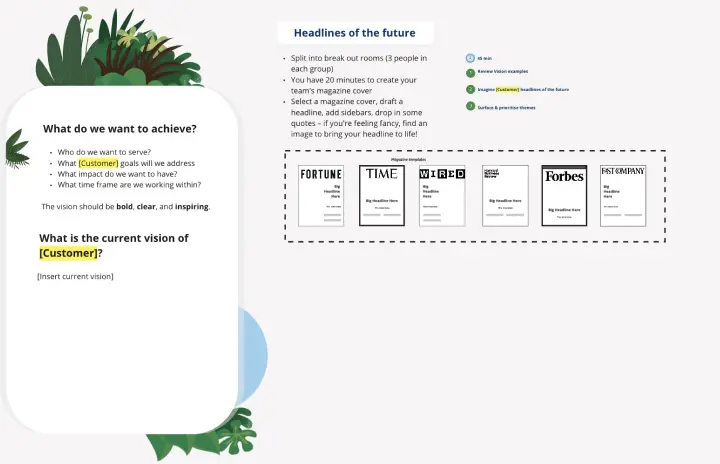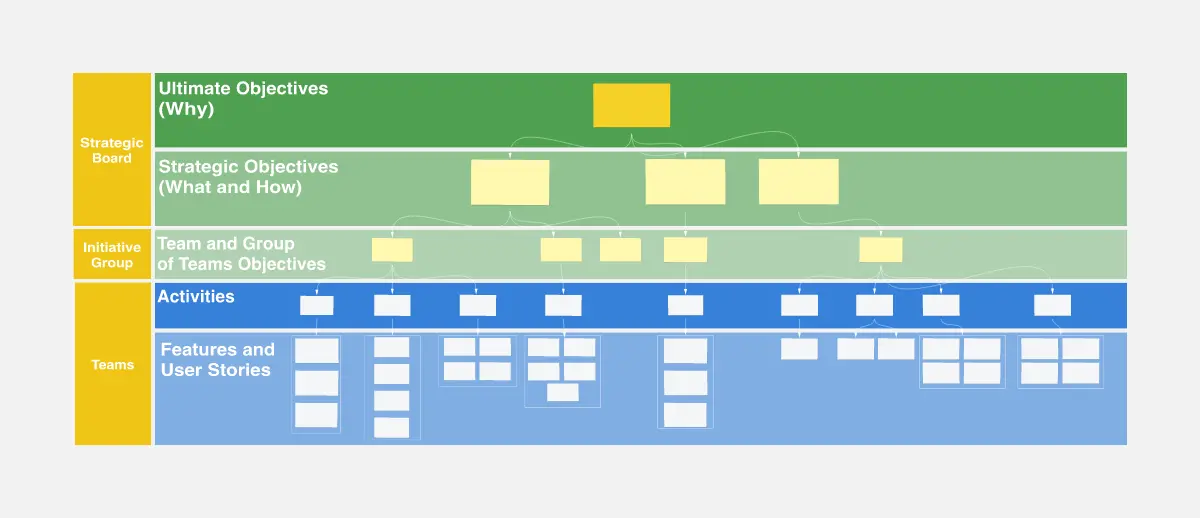About the OKR Planning Template
The OKR Planning template helps you run OKR sessions smoothly, with guidance on how to lead each part of the OKR planning process with clear instructions and pre-filled fields that you can edit as you see fit. When you need to align on Objectives and Key Results, leading OKR Planning sessions are a must. With this template, you can get your team aligned and focused on your business objectives and results with actionable items.
What is the OKR Planning Template?
The OKR Planning template is a mix of six templates that together help you lead OKR Planning sessions. This template provides you with a framework that guides you and your team through the whole OKR planning process -- before, during, and after your OKR planning meeting.
The OKR planning template contains six frames:
Icebreaker for the whole team
Overview of OKR-setting goals and topics
List of questions and answers
Brainstorming
Breakout group discussions
Action plan / next steps
Who is the OKR Planning Template for?
Meeting facilitators and team leads can use this OKR Planning template to prepare for and run OKR sessions with their teams. Meeting participants can also refer to this template pack to prep for an OKR planning meeting.
How to use the OKR Planning Template
The OKR Planning template is a framework containing six templates so you can lead a planning session smoothly and efficiently. Follow the steps below to run an OKR Planning meeting using this template:
Icebreaker for the whole team: Get the creative juices flowing and begin the session with an Icebreaker. On this template, the Love Bomb Icebreaker can make your team feel connected and appreciative of one another's strengths.
Goals and topics: At this stage, outline the meeting’s agenda and present any relevant information that you think you and your team will need for the session (for example, the company’s metrics, statistics, or an inspirational quote).
Questions and answers: After the OKR session’s brief introduction, allow the participants to ask questions and raise concerns. Be an active listener and understand your team’s worries, as this will be very important for the rest of the session to run smoothly.
Brainstorming session: Here is where the fun begins! Brainstorm with your team what areas you should focus on for the next period. Use the voting feature and allow everyone to have an active voice and engage in the discussion.
Co-create OKRs in breakout rooms: At this point, create breakout rooms and allow your team to discuss the topics from the brainstorming. After the discussion, they can come up with some possible key results and actionable points for reaching the company’s objectives.
Next steps and OKR planning: Define the objectives set by each group and clearly describe the risks and actions needed to achieve them.
Lastly, before celebrating the end of your OKR planning process, as a good practice for meeting facilitators, schedule a follow-up session to ensure everyone is aligned.
Miro helps you keep everything you need in one shared space, making it easy for you and your team to follow up and consult the OKR documentation even after your OKR planning meeting.
Why should you use an OKR planning template?
Collaborative planning: Enable real-time collaboration among team members. Multiple users can work on the OKR planning template simultaneously, fostering a collaborative environment for planning and goal-setting.
Flexibility and customization: Miro's flexibility allows teams to customize OKR templates based on their needs and organizational structure. This adaptability ensures that the template aligns with the team's unique goals.
Single source of truth: The OKR planning template serves as a centralized hub for all relevant information related to objectives and key results. This reduces confusion and ensures everyone is aligned with the same goals.
Efficient tracking: Track progress easily. Teams can update key results, mark achievements, and visualize progress towards objectives in real-time.
Iterative Planning: Miro supports a feedback-driven approach to OKR planning. Team members can provide comments, suggestions, and feedback directly on the template, fostering continuous improvement and iteration.
OKR Planning Template FAQs
How do you run an OKR planning meeting using this template pack?
You can use the OKR Planning template to help you organize your OKR Planning process from end-to-end, allowing you to define your team’s and company’s OKRs successfully. When you facilitate an OKR session, take into consideration how knowledgeable your audience is. Do they need more instructions? References? Do they have questions and concerns? As a meeting facilitator, try to be an active listener and tackle your team’s difficulties. Use Ice Breakers and Brainstorm sessions to invite everyone to engage and be involved throughout the process, allow discussions with Breakout rooms, and collect everyone’s actionable points for reaching the desired results.
Can I modify an OKR Planning Template to suit my organization's needs?
Yes, many OKR planning templates are customizable, allowing you to tailor them to your organization's specific goals, timelines, and criteria.
How can I ensure that an OKR planning template stays effective?
You should regularly review and update the OKR planning template as business priorities evolve. Make sure that your objectives are aligned with broader organizational goals.

Miro
The AI Innovation Workspace
Miro brings teams and AI together to plan, co-create, and build the next big thing, faster. Miro empowers 100M+ users to flow from early discovery through final delivery on a shared, AI-first canvas. By embedding AI where teamwork happens, Miro breaks down silos, improves alignment, and accelerates innovation. With the canvas as the prompt, Miro’s AI capabilities keep teams in the flow of work, scale shifts in ways of working, and, ultimately, drive organization-wide transformation
Categories
Similar templates
Objectives and Key Results (OKRs) Template

Objectives and Key Results (OKRs) Template
Clarity, focus, and structure — those are the key ingredients to feeling confident in your company’s directions and decisions, and an OKR framework is designed to give them to you. Working on two main levels — strategic and operational — OKRs (short for objectives and key results) help an organization’s leaders determine the strategic objectives and define quarterly key results, which are then connected to initiatives. That’s how OKRs empower teams to focus on solving the most pressing organizational problems they face.
Strategic Planning Board
V2MOM Workshop

V2MOM Workshop
Align goals and strategies across your organization with the Salesforce V2MOM Template. Bring everyone together towards the same goals.
Objectives and Key Results (OKRs) Template

Objectives and Key Results (OKRs) Template
Clarity, focus, and structure — those are the key ingredients to feeling confident in your company’s directions and decisions, and an OKR framework is designed to give them to you. Working on two main levels — strategic and operational — OKRs (short for objectives and key results) help an organization’s leaders determine the strategic objectives and define quarterly key results, which are then connected to initiatives. That’s how OKRs empower teams to focus on solving the most pressing organizational problems they face.
Strategic Planning Board
V2MOM Workshop

V2MOM Workshop
Align goals and strategies across your organization with the Salesforce V2MOM Template. Bring everyone together towards the same goals.
